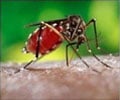When a vaccine to prevent malaria is licensed and ready for dispensing the vaccine to three-month old infants via the WHO's Expanded Programme on Immunization (EPI) will be the most effective.
When a vaccine to prevent malaria is licensed and ready for use (example the research malaria vaccine RTS,S, which is now appears hopeful), dispensing the vaccine to three-month old infants via the World Health Organization's Expanded Programme on Immunization (EPI) will be most effective mechanism in high transmission areas but for lower transmission areas, mass vaccination every 5 years might be a more efficient vaccination strategy, finds a new study.
In a modelling study led by Thomas Smith from the Public Health Institute in Basel, Switzerland, and published in this week's
PLoS Medicine, the authors used 14 different models that simulated the transmission of the parasite that causes malaria (
P. falciparum) in thousands of hypothetical individuals through different stages of malaria infection. The authors used each model to predict the health benefits over 14 years of the potential malaria vaccine RTS,S given by different vaccination strategies and found that the predicted benefits of giving the malaria vaccine using the EPI strategy were modest and similar over a wide-range of settings. However, EPI with an initial catch-up phase averted the most deaths per vaccine dose in individuals who had over 10 infectious malaria bites a year but in areas where people typically have two or less infectious mosquito bites a year, the authors' model found that mass vaccination strategies substantially reduced transmission leading to much greater health effects per dose than other strategies, even at modest coverage.
This study only reports the first stages of using ensemble modelling to predict the health effects of RTS,S vaccination, so future studies will need to combine the outputs of multiple models with economic analyses to provide a rational basis for the design of vaccine-containing malaria control and elimination programs.
The authors say: "The ensemble modeling approach provides more robust outcomes than single models, and our analyses suggest that such an approach produces greater confidence in predictions of health effects for lower malaria transmission settings than for higher ones."
The authors continue: "This study suggests that targeted mass vaccination with RTS,S in low transmission settings may be more efficient than national-level introduction via EPI programs, but there remains a need to analyze the feasibility and economics of such strategies and the circumstances in which vaccination will avert epidemics."
Source-Eurekalert











